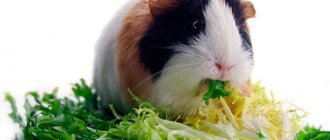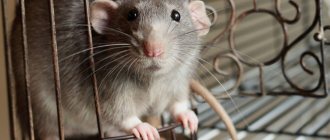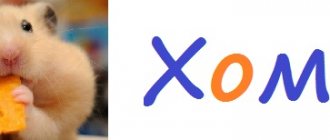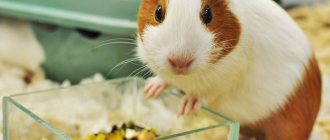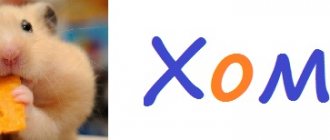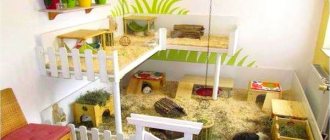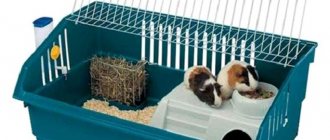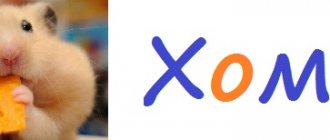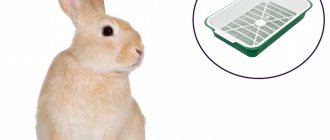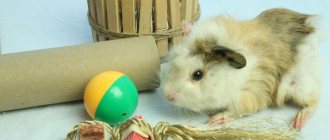Funny, peaceful guinea pigs are popular among pet lovers. These animals live in cages, do not cause much trouble, and give a lot of positive emotions. But there is one drawback to keeping these animals. Even with regular cleaning of the cage, an unpleasant odor from your pet's excrement appears. The problem can be eliminated by properly arranging a toilet for the animal, which is easy to clean and maintain order in the cage. However, it should be taken into account that the process of accustoming an animal to a tray is quite complex and will require a lot of patience. There are certain rules and techniques that allow you to instill such a useful skill in a rodent.
Features of behavior
Character
They are calm and friendly, love to play and run around the apartment.
Animals often lick their owner’s hands. This is how they express gratitude for your attention and love.
A guinea pig is a social animal that craves communication, affection and love. If you decide to have one, then keep in mind that you can’t just leave them alone, for them it’s a lot of stress, boredom and, as a result, a serious shortening of life
It is better to pay enough attention to them or bring a second relative into the house
When stressed, they can become aggressive and bite hard. Most often this happens when the animal is scared or unhappy (if you tear it away from food, for example). Stress is especially pronounced during a move; at this time it is better to leave the pet alone and give it time to adapt. Also, the animal can show aggression before bedtime.
Behavior
Guinea pigs have excellent hearing, so in nature they use verbal signals that allow them to communicate with each other and transmit information
- A shrill squeak. If you hear it from your pet, know that he demands to be fed immediately.
- Clicking - with this signal the guinea pig wants to say that you are crossing the boundaries of its personal space and demands that you respect its tendency to be alone.
- “Cooing” is great, he wants to thank you for finally deigning to feed him or stroke his fur.
- A quiet whistle - the animal is clearly scared and wants a hug.
- Grunting - this sound is incomparable to anything. You will hear it when your guinea pig sees another pet.
To determine their mood, it is enough to observe their behavior. A sign of a good mood is that the guinea pig is active. She runs, jumps, buries herself in sawdust. This suggests that she is satisfied with everything. If the animal sits motionless for several hours, then this is a call. This means he doesn’t like something and may have health problems.
How to stop shitting anywhere?
It is quite possible to stop a cat from shitting in the wrong place. Although it is initially worth determining whether the pet has health problems. If the reason is different, you can use one of the following techniques:
- Try to keep track of when your pet is going to go to the toilet and take him to the litter box. This usually occurs after feeding or sleeping;
- Treat all “marked” areas with disinfectants that kill odors;
- You can treat the carpet with products with a citrus scent, which cats do not like;
- It is recommended to place the bowl in the place where the cat pooped. Clean pets will never mark where they eat;
- You can also put the potty in the place where the cat shitted so that he gets used to the toilet, and then move it to the previously designated place.
When using carpet or floor cleaners, you need to make sure that they completely eliminate the smell of urine. If he stays, the cat will return there and leave his marks. By the way, it is not recommended to use bleach because it attracts cats back. It is better to replace it with water and vinegar.
Situations when a cat shits in the bed deserve special attention. You need to stop doing this as quickly as possible, otherwise the unpleasant odors will be impossible to remove. In this case, you need to have a spray bottle of water with you, which should be with you at all times. As soon as the animal moves onto the bed to relieve itself, you need to spray water on it. It is enough to repeat this trick three or four times to wean your cat from shitting in the wrong place.
Adaptation to a new place
They begin the taming process only after the animal gets used to its new housing.
In order for this period to pass favorably for the animal, it is necessary to provide suitable conditions for this:
- In the room where the animal's cage is located, you should not make loud, sharp sounds. It is not advisable to install the cage near sources of constant noise. Rodents have very sensitive hearing and a delicate nervous system.
- There should always be water in the drinking bowl, and the feeder should be filled with tasty food. The rodent must be sure that it can drink and eat at any time without being disturbed by anyone.
- A house is immediately installed in the cage, where the pig can hide from prying eyes, or you need to put a large pile of hay.
- Other pets that live in the house should not be introduced to the pig prematurely. They can scare her and it will not be easy to calm her down.
- When cleaning the cage or other manipulations related to keeping a rodent, everything must be done extremely carefully, without sudden movements.
- It’s too early to organize walks around the apartment. The pet does not yet know where the house is and will be scared when they start catching it. He will have the opportunity to begin exploring the surrounding area if there is an aviary next to the cage.
There is another rule that causes controversy among pig owners; it says that the rodent should not be picked up at first. Each pet already has previous experience interacting with people. If it was successful, the pig will want to feel the hands of the new owner. Cases are described when an animal becomes calmer in your arms. With such animals there will be no problems with training and taming in the future. You can pick up a guinea pig on the first day only if you are absolutely sure that it will not cause rejection.
Most often, at first, the guinea pig will avoid contact and look closely at everything that is happening around.
Team training
After taming, they begin to train guinea pigs
It is important to remember that you should not shout at your pet or use force against it.
You should not try to master all the tricks in one training session. It is better to start with simple commands, and after successfully mastering them, move on to more complex options.
The tasty reward should be removed gradually and only after the command has been fully mastered.
Stand
The simplest command for any animal. To teach this command to a guinea pig, you need to place the animal on a flat, hard surface. A treat is held over the pet's head. The animal reaches for the treat, at which time the owner calmly says “stop.” The animal can reach the treat by standing on its hind legs. When this happens, the animal is praised and treated. The command must be repeated several times and the pet must be treated. These actions need to be repeated until the animal understands what is required of it. After mastering the command, it is repeated periodically so that the pet does not forget.
To me
This team will need about two weeks to train. To begin with, the rodent is placed on a flat surface a meter from the owner. Then the owner shows the pig a treat and calls him by name in a calm voice. As soon as the animal approaches, you need to pet it and treat it with a treat. It is better to do classes every day. After mastering the command, the distance between the student and the teacher is increased.
U-turn
To execute this command, you need to bring the treat over your pet's head. When the pig becomes interested in the treat, you need to slowly begin to describe a circle above the animal’s head. It is better to move your hand clockwise, while repeating the command “circle” or “turn around”. You should not immediately make a circle if the animal quickly loses interest in the treat. You can first make turns of 45 degrees, then 90 and until the turn is complete. You need to train every day so that the animal does not forget the learned elements.
Kiss
It doesn't take much effort or training to execute this command. All you need to do is hold a piece of the animal’s favorite treat with your lips. Then you need to bring the pig to the owner's head. As soon as the pet smells the tasty treat, it will reach out to its owner’s lips and take a piece.
Give me your paw
This command is more difficult to execute than the previous ones. To do this, you need to put the pig on the sofa. The owner himself is located in front of the rodent on the floor. He extends his left hand, palm up, towards the animal, and with his right hand he lures the animal with a treat. When the animal begins to move towards the person, the owner gives the command “give me your paw.” And as soon as the student’s paw is in his hand, the animal is praised and treated to something tasty.
It is important to be careful so that the animal does not fall on the floor
Achieving results in executing this command requires regular training.
Roll the ball
This command is also based on the guinea pig's natural desire to eat. To execute the command you need a ping pong ball or other small light ball, a strip of carrot or celery. Place the treat under the ball and wait for the pet to become interested in it. And then you can give the command “Push.” To get the treat, the pig will have to push the ball with its muzzle. This team needs to be trained regularly to achieve results. After a few sessions, the bait is removed from under the ball.
Jump through the ring
This command will require a ring and a treat. You can make the ring yourself from wire or use a tennis racket after removing the fishing line.
First, the ring is placed edge-on on the floor. A pig is placed on one side of the ring, and a treat on the other. Having noticed the treat, the pet will go to it through the ring. At the same time, the owner gives the command “ring”. If your pet doesn’t see the treat, you need to move it closer.
As soon as the pig gets through the ring, he should be praised and allowed to treat himself. Over time, the ring is raised. The final lifting height of the ring is considered to be a distance of 3 cm.
Trained guinea pigs are not exotic, but a completely normal phenomenon. Each owner can teach the animal to follow commands in order to develop it and entertain it. And the owner will also have a pleasant time with his pet.
Communication with other guinea pigs
Animal care experience shows that two female guinea pigs can easily get along together at any age. It also turns out that a male and a female have a good family, but then you need to be prepared for constant replenishment of the family. One male and several females live together.
Two males sometimes get along only if there is no female nearby. It is possible that they will suddenly want to fight, even if they have spent a lot of time together before, so it is better not to keep two boys together. These contractions can be very brutal. But these animals never fight over food.
After acquiring a second guinea pig, you should not immediately place it with your pet; it should live separately for at least a week. This is to make sure that the new pet does not suffer from any diseases. After the end of the week-long quarantine, you can bring them together.
Photo: Depositphotos
Before meeting, you need to thoroughly clean the walking area so that there are no foreign odors there. Food needs to be scattered throughout the cage to avoid conflicts over food. After the pets have been united, it is advisable to look after them all day.
Guinea pigs will sniff each other and squeak. By low whistling, animals communicate a threat or it is a sign of normal courtship. They may also grumble and chatter their teeth. The last gesture, combined with raising its paws and body, means that the animal tells the enemy that it is ready to start fighting for primacy.
Guinea pigs may begin to walk around another animal in circles and jump on each other. Usually, pouncing is an expression of sexual behavior, but sometimes, if the animals are same-sex, it means that one of the guinea pigs wants to show dominance to the other. Females who are harassed by a male may retaliate by releasing a stream of urine at him.
All of the above is normal and should not be alarming. Usually after a few days the animals calm down. But if it comes to a serious fight, the guinea pigs need to be separated with a net and after a while try to bring them together again. Sometimes all attempts to reconcile animals are pointless. Then you need to think about another partner.
Photo: Depositphotos
How to hold a pig correctly
It is very important to learn how to properly hold an animal in your arms. Although this animal is small in size, it is relatively heavy.
Therefore, if you hold him up, it may hurt him. Therefore, he must be able to rely on the owner.
So, let's learn how to hold a guinea pig in your arms correctly:
- one palm is placed behind the front paws, clasping the chest;
- with the other hand, carefully support the back;
- you need to hold the animal tightly, but not too squeezing.
The Cavie's build is not at all conducive to striking. A fall, even from the smallest height, can cause severe bruising, injury and lead to the death of your pet.
Training methods
Most likely, your pet has already chosen a permanent place for her needs. In this case, all that remains is to buy a tray for rats or make one from an unnecessary food container and secure it so that the animal does not move it during use.
If you choose a special litter that is unfamiliar to the rat by smell, you need to put some of its droppings and already used litter in the new litter box. Reward your pet every time he goes to the litter box with a treat.
When there are several rats living in a cage, each one usually has its own latrine. The solution to the problem (if the size of the cage allows) is several containers placed where traces of urine and excrement are most often visible.
https://youtube.com/watch?v=iL4K7zXmGeM
Some individuals relieve themselves in different parts of the home. In this case, you will have to stock up on endurance and perseverance in order to accustom him to the toilet in one place. Here you need to proceed in this way:
- Remove the filler from the cage, rinse the cage thoroughly and disinfect it to remove the odor.
- Place a clean cloth, waffle towel or diaper on the bottom. If the animal begins to chew on such bedding, you will have to replace it with a more traditional one, but different from the litter for the tray.
- Fill the container by adding the already used litter and rat droppings.
- put the rat in the tray, and when the pet uses the toilet, give a treat.
You will have to watch the animal for several days. Regularly put him in the tray, and then be sure to encourage him.
Sometimes it can be difficult to accustom a rat to a litter tray, especially for adult rats. You cannot shout or punish the animal. Your shouting and wrong actions will only scare him.
It is up to you to help your pet understand the difference between the toilet area and the living area of the cage. To do this, immediately remove the wet piece of litter and excrement. At first, you will have to do this several times a day. When replacing the litter, do not forget to leave some of it in the container, and also add droppings there.
Types of trays and fillers: choosing the best
Tray selection
To select the most suitable tray, you first need to pay attention to the following parameters:
- Tray size;
- the thickness of its walls;
- mounting methods provided by the manufacturer;
- tray shape;
- the height of its sides.
In this case, the trays, as a rule, are as follows:
- Corner trays designed for left or right corners. The main advantage of such trays is that it is quite possible to fix them simultaneously on two walls of the cage;
- Rectangular trays. The advantage of such trays is their stability, as well as their large area.
- Curly, more beautiful trays. The only usefulness of such trays is that guinea pigs can simply rest in them. However, it is impossible to fasten them close to the walls of the cell.
Considering that pigs like to relieve themselves in the corners of their homes, most owners prefer a corner shape of the tray. Of course, it is quite possible to install a rectangular toilet in the corner of the cage, but a corner one will take up much less space.
IMPORTANT: The future tray must be selected based on the size of the animal itself, as well as its cage. This way, the litter box will move in and out of the cage without difficulty, and your rodent will be comfortable and comfortable with the new toilet.
Manufacturers of trays for guinea pigs and other rodents often use non-toxic plastic for these accessories.
Trays made of this material are easy to clean and do not become saturated with an unpleasant odor for a long time. Have you decided to take a corner toilet or a rectangular one?
How to choose a filler
To organize a toilet for a guinea pig, you should definitely give preference exclusively to high-quality litter. This is required primarily so that the fillers can absorb excess liquid well, as well as unpleasant odors. Otherwise, you will have to clean the tray two or even three times a day.
The most popular filler options for a guinea pig litter box:
- Wooden sawdust. The main disadvantage of a sawdust tray is that the wood chips take too long to dry. Because of this, pig owners have to clean their cages much more often than they would like. The advantage of this filler is that guinea pigs simply adore such natural compounds. They can also use sawdust to grind down teeth.
- Sand from the river. Before direct use of such filler, it must be thoroughly washed and dried under natural conditions. This is important in order to protect your pet from possible infections and diseases.
- Clay. This component is quite in demand in modern pet stores, as it perfectly absorbs both unpleasant odors and excess moisture, which greatly simplifies the process of cleaning your pet’s home. However, clay contains a high content of quartz dust, which can cause significant harm to the health of guinea pigs.
- Cat litter. Even despite the fact that these pets are in no way similar to each other, cat litter is perfect for any of the rodents.
Carefully monitor the behavior of the animal - install the toilet where it most often goes to the toilet
Is it possible to train a guinea pig to a litter box?
It is much more difficult to develop the skill of toilet behavior in a fluffy rodent than in a kitten or puppy, but it is quite possible
With due attention, care and diligence, guinea pigs can be potty trained, so in this regard they are not so different from other animals. Moreover, pigs of any age category are amenable to training of this kind: from very young children to adults.
As guinea pigs grow up, they try to do their toileting in more hidden places, which, as a rule, are the far corners of the cages. After carefully observing your fluffy for a while, you need to place the tray in the place that the pig prefers most for going to the toilet. Moreover, many guinea pigs immediately understand the purpose of a new item in their home and are happy to use it for its intended purpose.
Creating a tray at home
If there are no suitable designs in the store, you can try to make a toilet yourself. Taking into account the specifics of the required design and the demanding nature of rodents, experienced owners offer 3 options:
- purchase a triangular-shaped plastic lunch box, cut it so that it acquires the necessary features. Sharp edges should be processed so that the animal does not receive damage, and holes should be made for strong fastening;
- Use a plastic scoop with a suitable shaped bottom. The handle should be cut off, and then all the edges should be processed and firmly secured;
- if a rectangular tray is required, then any plastic box of suitable size will easily serve as this.
You can make a tray for a guinea pig from a lunch box with your own hands.
It must be remembered that the time spent on toilet training a pet requires more than in the case of a cat.
Initially, shy animals may not control natural physiological processes, so it is important to first tame it, allow it to get used to itself, and only then begin to deal with sanitary issues.
How to toilet train?
How to toilet train? ¶
From: Pavel - December 24, 2007 5:20 pm
How to toilet train a guinea pig so that it doesn't poop all over its cage?
How to toilet train? ¶
From: luscinia - December 24, 2007 6:17 pm
Usually pigs themselves determine a corner for the toilet, sometimes more than one, but then they rush around the cage and scatter droppings throughout the entire territory.
How to toilet train? ¶
From: Barefooted Gen - December 26, 2007 10:29 am
How to toilet train? ¶
From: luscinia - December 26, 2007 1:15 pm
The grates are made and no holes are required in the corners; all “waste” falls through the grate. But walking on a lattice is inconvenient and dangerous for pigs - a leg may fall through and injury is possible. The pig is not a rat or a hamster; it cannot walk on lattice structures. A layer of sawdust is still safer.
How to toilet train? ¶
From: Barefooted Gen - December 26, 2007 2:25 pm
How to toilet train? ¶
From: Sana - December 26, 2007 6:44 pm
From my own experience, I was convinced that only in a large cage (from 1 meter) do pigs clearly allocate space for sleeping, for the toilet, etc. But it is possible that I have such pigs.
How to toilet train? ¶
From: Barefooted Gen - December 27, 2007 10:20 am
How to toilet train? ¶
From: Markiza75 - December 27, 2007 1:23 pm
How to toilet train? ¶
From: L_enok - December 29, 2007 15:46
My first pig was a neat little pig, she only peed and pooped in the corner, always in one. I didn’t work and only did it. She pees, and I put this piece of paper (tual.boom) in the corner, the second time she goes straight there. Then we got used to doing without these tricks. But now there are truly two little pigs! They pee wherever they want, sometimes in a cage I clean it twice a day. And the method with a piece of paper didn’t work. So, it seems to me that cleanliness is inherent in their character. Some people lick themselves several times a day. and someone manages to lie down to rest exactly where everything is described.
Typical mistakes when organizing a toilet
Many owners force things and force their pets to use the toilet at any cost.
You should not shout at guinea pigs, much less hit them. The psychology of these rodents is such that they will not associate the owner’s anger and physical pain with the discharge of natural needs.
Article on the topic: Carrying for a guinea pig and rules for transporting a pet in transport
Very often a tray is selected with high sides or without them at all. In the first case, it is difficult for the rodent to climb, and in the second, the filler will constantly spill out.
Many owners make the common mistake of using cat litter, which forms hard clumps when wet. Rodents mistakenly start gnawing on them and get indigestion.
The pig, even trained to the litter box, refuses to go into it if it is not cleaned. It is advisable to wash the tray once every 10-15 days, and change the filler as it gets dirty. This way, the remaining smell will attract the pig, and the fresh litter will not repel the animal.
Often lightweight trays easily turn over; hook-type fastenings do not protect them from this. It is advisable to buy a toilet that is secured with reliable latches.
Choosing a tray and filler for a guinea pig is an individual matter; what is good for one may not be suitable for another. Sometimes the owner has to find a solution through trial and error.
Choosing a home for a guinea pig
The choice of housing for a guinea pig comes down to 4 options: cage, terrarium, container and enclosure. All of these types of houses are acceptable for keeping a rodent. But each type of house has its own characteristics.
Cell
Breeders of these cute rodents believe that this is the best option. In a cage, the pet is protected, it cannot get out on its own and go wandering around the apartment, and there is also good air circulation in it. There is only one drawback in such a house - food and bedding scatter around the cage, and the garbage has to be removed daily.
To make the animal comfortable, the cage must be:
- Spacious. A cage of at least 90 cm in length, 40 cm in height and 60 cm in width is suitable for one pet. For two individuals kept together, the cage length must be at least 120 cm and width 80 cm.
- With plastic tray. If the cage does not have a tray and there are only metal bars on the floor, then the animal’s paws may get stuck. This will lead to injury.
- Not tall. Multi-tier cages are not intended for pigs. Pigs do not know how to jump and deftly climb to the upper floors. Therefore, trying to climb higher can lead to injury. But even if the animal climbs up, problems may arise with the descent.
Terrarium
Connoisseurs do not welcome it when a pig is kept in a terrarium. Its blank walls interfere with ventilation. And this leads to the fact that the terrarium will be hot and stuffy. The bedding in this type of pig house does not dry out. To create air circulation, the side walls of the terrarium are made of mesh.
But this is a “cleaner” type of housing, since sawdust and hay do not fly in different directions from the terrarium, and there is less cleaning.
Aviary
An aviary is the best type of housing for a pig if there are no cats or dogs in the house. The size of the enclosure can be much larger than that of a cage or terrarium, which provides the rodent with more space. The walls of the enclosure are made at least 40 cm high so that the pet cannot climb over it. An aviary is also an economical option.
Plastic container
This type of housing is also called “Dune”. Breeders do not recommend keeping animals there. The container is designed with a plastic tray and a plastic lid with holes. Despite the holes, the flow of fresh air is not enough for the pig to feel comfortable in it. And the dimensions of the container are not large enough for the pig to have room to roam. “Dune” is convenient to use as a carry bag in warm weather.
Rules for arranging a toilet for a pet
The choice of tray must be done carefully. The animal should feel comfortable in it. The cage is equipped with a structure made of durable plastic of optimal thickness corresponding to the load. The dimensions of the tray are selected taking into account the size of the animal. The guinea pig needs to be provided with convenient entry and exit from the toilet. If she is uncomfortable, it will be impossible to toilet train her. Plastic must not contain components that pose a danger to living beings.
The tray configuration can be any. The best option is a corner design that occupies a minimum amount of usable space. The device must be securely fixed.
The toilet filler also deserves attention. Do not use formulations intended for cats. These fillers harden upon contact with moisture. The guinea pig will certainly chew the lumps, which will lead to poisoning. For these pets, you should purchase other types of fillers, it can be:
Experts recommend placing sawdust from deciduous trees in the tray. This material absorbs moisture and odor efficiently and prevents injury to the animal. Pet stores sell wood pellets. You can use such a filler, but it needs to be changed regularly, since the granules crumble, turning into dust that will stick to the plastic. Material made from softwood should not be used in a guinea pig litter box.
Herbal fillers have decent qualities. Corn pellets are a popular option. They perfectly absorb odors and absorb moisture. Such products are more expensive than sawdust. But if your pet prefers such a filler, it is better to take into account his interests so as not to discourage him from going to the litter box.
Fillers made from synthetic components transform into a gel when moisture comes into contact with them, which makes cleaning easy. But you need to take into account that these products can be toxic. Some owners place a fleece bedding on top of the filler and wash it when it gets dirty.
After purchasing a tray and filler, you can begin arranging a toilet for your pet. Several rules must be followed:
- The litter box should be placed in the area that your guinea pig has chosen to use the toilet.
- You need to make sure that the design matches the size of the animal and guarantees ease of use.
- After filling the tray, you need to observe the animal’s reaction to make sure that the filler does not cause negative emotions in it.
If your pet does not have one specific place to go to the toilet, it may be necessary to install several litter trays.
How to properly dry guinea pigs after bathing
Not everyone is able to dry their guinea pig with a hairdryer after bathing. Noise and a strong flow of hot air frighten the animal no less than water. If your pet is not accustomed to this device, it is better not to use it.
In this case, drying is done with a towel. Guinea pig fur gets wet well. To remove residual moisture from the fur, you will need a second towel or flannelette diaper. Next, the animal is placed in the warmest place in the house and kept there until completely dry.
It is still better to dry a long-haired guinea pig with a hairdryer. The device is turned on at the lowest power and temperature and kept at a distance of at least 40 cm from the animal. The air flow is directed along the hair growth. After drying, the pig is combed and treated to its favorite treat.
How to stop shitting in flowers and on the carpet?
Some pets perceive a pot with soil as a litter box. But animal urine can lead to the death of the flower, so you need to wean yourself from the habit of peeing in a pot. You can do it like this:
- Place a piece of lemon near the flowers, the smell of which will distract;
- Make window sills slippery using bags. It will be more difficult for the cat to reach, and she will change her mind about marking near the potty;
- Equip the windowsill with a mini-fence;
- Stick a few toothpicks or matches into the ground near the flowers.
But the most popular place for cats to relieve themselves is the carpet. In this case, you need to wash it well and get rid of the smell. This is best done by dry cleaning, although you can also do it yourself. Various disinfectants or vinegar are suitable for this. It is also recommended to treat the carpet with essential oils, such as orange or bergamot. Smells are also particularly repulsive to cats.
Taming methods
Over time and with the proper approach, the pet gets used to the person and is less afraid. After complete adaptation to the new place of residence, you can continue to tame the animal. In this case, the time spent can be very different, everything will depend on the nature of the pet.
Getting used to the owner
You can tame a guinea pig to its owner in stages:
- The owner should constantly talk to the pet in a gentle and calm voice, while simultaneously offering the animal treats.
- As soon as the animal begins to calmly react to the presence of a person, they move on to taming it by hand. To do this, open the cage door and offer the pet a treat, at the same time allowing you to sniff your hands.
- When the animal begins to calmly accept treats from human hands, you can try to slowly stroke it. However, to prevent your pet from perceiving your actions as aggression, you should not touch his rump.
- A little later, you can pet the animal without giving it a treat. It will gradually become clear whether the animal likes such actions or not.
- After mastering stroking, you can begin to pick up your guinea pig.
- In order for the adaptation to the owner to go smoothly, it is recommended to avoid situations that are unpleasant for the animal. Try to avoid actions that cause any discomfort to your pet.
- The cavey should be handled correctly, held and stroked in such a way that it feels good.
Getting to know the toilet
Many people are convinced that it is impossible to litter train a guinea pig. However, this opinion is wrong. Rodents have developed intelligence to understand where to defecate.
There are many different types of trays for pigs, but they are usually containers with a hole so that the animal can freely climb inside.
You can toilet train your guinea pig using granular litter.
It compares favorably with other materials in that it perfectly absorbs moisture. This means that such a filler will have to be changed quite rarely, thereby disturbing the pig less.
One of the most important points is choosing the optimal location for the toilet. You need to take a close look at the animal and understand where it goes all the time. It is recommended to place the toilet in this place.
Place some used litter in the tray. When the animal wakes up, you need to put it in front of the tray. By smell, he will quickly determine what the structure is intended for. If the animal refuses to go to the designated place, then you can install several toilets at once so that the animal chooses the one it likes.
In this matter, it is very important to be patient, because gradually the pet will understand what’s what
Common mistakes
To quickly teach your pet to go to the toilet in one place, you need to avoid a number of mistakes. It is forbidden:
- yell at your pets or hit them. The rodent’s mind does not associate the owner’s anger and the “toilet” mistake;
- choose a tray with or without a high side. The animal will either not be able to fit into its own toilet, or the filler will scatter throughout the cage;
- use cat litter. When wet, its structure changes and hard lumps appear. Pigs gnaw on them, which is fraught with diseases of the digestive system;
- forgetting to clean your guinea pig's litter box. The animal refuses to climb into something overflowing with urine or feces.
You cannot buy a device without fasteners. If it constantly turns over, the pet will not perceive the device as a closet.
Additional tips and tricks
Guinea pigs are easy to care for. It is enough to equip the cage correctly, feed it delicious food, and the pet will be happy. But training enthusiasts will need to establish contact with the future artist.
You can tame a guinea pig to your hands only through daily exercise for 20–30 minutes. The rodent should be held in your arms, stroked on the back, and scratched on the tummy.
Pets love to stretch their legs and travel around the apartment. The main thing is to keep an eye on them, otherwise they may chew on electrical wiring or hide in a secluded place.
There is an opinion that taming guinea pigs is a thankless task. In fact, animals are capable of performing simple tricks if you follow the rules of training. Patience, care, and delicious food will help the animal master simple commands based on a conditioned signal.
Cell options
Owners of pet rodents are offered many options for homes. Let's try to study their strengths and weaknesses and determine whether they are all really suitable for pigs.
Aquarium and terrarium
Aquariums for guinea pigs have only two advantages - they are easy to clean and prevent debris from falling out of the cage. Unfortunately, in other respects glass vessels show their absolute unsuitability:
- lack of ventilation;
- accumulation of ammonia vapors and inhalation by animals;
- complete isolation of rodents from the outside world: pigs are not able to perceive anything through glass.
Inexperienced owners also consider guinea pig terrariums as housing, but these containers are not much different from aquariums. The conditions inside them are suitable only for flightless animals such as amphibians and reptiles, as well as insects. Rodents cannot live in terrariums.
Dune
Dune is a plastic container with a hole at the top. It has the same disadvantage as a glass cage - a complete lack of fresh air.
The reason for such a large number of plastic houses on the product market is low cost. This option can only be considered as a temporary habitat for the pig or a carrier.
For chinchillas, degus or birds
Cages for rats, chinchillas or birds should absolutely not be used as houses for guinea pigs, as they are tall and narrow:
- there will not be enough space for the pig to move around on the floor;
- the animal may be injured when trying to climb to the upper levels: the safe height to which a rodent can climb is only 10–15 cm.
Shelving
The trend to use shelving for keeping pets came from the West and is successfully taking root in Russia. The rack is a large cage for a guinea pig, it looks like a fence and is made of wood. Glass or metal mesh is also used to make it.
What are the benefits of racks:
- environmentally friendly and durable materials are used for creation;
- spaciousness and the ability to accommodate several rodents.
The shelving house, unfortunately, is quite heavy and bulky, so it takes up a lot of space in the apartment.
Lattice
Cages with bars, which are usually intended for hamsters, are characterized by the following negative features:
- The size of the guinea pig cage should correspond to standard parameters. And in homes for hamsters there is not enough space - the pet will begin to get nervous and behave inappropriately, and may get sick.
- Often the cage bars are covered with enamel to create a more presentable appearance. Pigs, accustomed to chewing everything, can swallow it and get poisoned.
The positive aspects of such structures:
- ventilation;
- strength;
- wide choose;
- Convenience of attaching accessories (drinkers, hammocks) to the bars.
Theoretically, if you solve the issue of dimensions and make a large cage, then lattice houses have a right to exist.
Aviaries
Making enclosures for guinea pigs with your own hands is not at all difficult, and they also have many advantages:
- space;
- being in the fresh air;
- beneficial physical activity.
However, not all owners have the opportunity to organize summer pens: the structure requires a courtyard and a safe area where it can be placed.
Diversity of our assortment
Models of pens and enclosures are made of metal with galvanization or powder coating in different shades, with different diameters of rods and the distance between them. The range also includes options with a wooden frame with a durable metal mesh or fabric pens made of wear-resistant polyester with a rubberized bottom.
Advantages of the designs:
- thoughtful design,
- nice appearance,
- reliability and stability,
- mobility,
- ease of assembly,
- long service life.
Some models of enclosures for chinchillas and other rodents are equipped with a floor and roof made of solid, mesh or combined material. For convenience, the pens are equipped with doors or hatches. Depending on the intended placement, you can choose an option with a floor and ceiling or only a metal structure and individual accessories. You can also compare products on the site and choose the most suitable one.
Learning difficult tricks
Guinea pigs are capable students. Trained rodents clearly know the sequence of performing the act: command-action-treat. Training is based on the formation of conditioned reflexes that help perform the task correctly.
The result will not be long in coming if people follow the basic principles of domestication:
- Interest. Rodents love to eat, so the main incentive for them is tasty food. Slices of fruits, vegetables, and dried fruits are suitable as treats. Observing your pet will help you understand which of the proposed products is of particular interest.
- Sound signal. Each trick during training must be reinforced with a certain sound (word, whistle, knock).
- Action. Guinea pigs are not particularly flexible or graceful, so you should not expect complex maneuvers from them. The pet should like the game.
- Increasing difficulty. Training begins with simple techniques. The actions become more difficult when the previous tricks are fully mastered.
Weasel helps in mastering skills. The peaceful atmosphere, smell and calm voice of the owner set the pet up for communication
Conditioned reflexes are easily developed by careful handling of the animal
Give me your paw
In nature, guinea pigs do not push food towards themselves with their paws. But you can train an animal to perform a trick with the help of a cunning maneuver. One palm is brought to the pet's face, the other is held with a treat. To bite off a piece, the pig will have to place its paw on an outstretched palm. During training, the command “give me your paw” should be heard.
Football player
Guinea pigs play football in an original way: they hit the ball with their muzzle. A beginning football player is not fed for 8–12 hours before training.
Training is carried out in a spacious enclosure. The size of the ball doesn't matter. The main thing is that it is light. Place a sprig of greenery under the ball and wait for the pet to smell the treat. To take food, the animal will roll the ball to the side. During training, the command “roll” should sound. Gradually the pig will learn to roll the ball around the entire pen.
Jump through the ring
The trick can be done by an experienced circus performer. The owner places a ring (diameter 20–30 cm) between the pet and the treat. When the “ring” sound is made, the guinea pig is gently nudged so that it steps over the lower rim. During training, the ring is raised to a height of 4–5 cm.
On the shoulder
Rodents love to watch what is happening from above. Lure a pig onto your shoulder with treats
It is important that the animal makes the journey on its own. If you put him on your shoulder, he may get scared
Prevention
What can I do to prevent my pig from becoming constipated? You need to organize proper care. First of all, we are talking about nutrition and hygiene. The diet must be properly organized
It is important to understand what to feed the animal correctly
Fecal consolidation can occur due to lack of activity. It is recommended to take your pet for a walk at least once a week. The cage should be large enough to allow a good level of activity. It’s good if the cages have additional accessories that promote greater mobility. Give more succulent food, but do not forget about solid food so as not to provoke diarrhea. Make sure that you do not include prohibited or poisonous foods in your diet. Make sure the water in the drinking bowl is fresh and your pet knows how to use it.
Buying a tray
Mini pigs will need their own litter box; the pig will never share it with other pets.
The pet store does not sell special trays for pigs. We'll have to look for an alternative.
A spacious plastic box with low sides will do; your pig will definitely like it. It is better to take a large box right away - for growth.
Some people use children's plastic bathtubs or swimming pools as toilets. You need to cut the entrance and the toilet is ready! Some models already include an input.
You can use a bath as a tray. Lay down an anti-slip rubber mat. This will protect the pig from sprains and injuries.
Wash the tray or tub daily. To eliminate unpleasant odors, add baking soda and talc to the bottom.
To train your piglet, take some toilet paper and feces and place it in a new litter box. This way the pig will navigate by smell. Leave the remaining droppings in the tray so that the pig will be guided by the smell where to go to relieve itself.
After completing the procedure, you should not treat your pet with a treat for encouragement. This may confuse him. It is necessary for the pig to understand that it is his direct responsibility to relieve himself in the litter tray!
During the learning process, the pig may make a mistake; you should not punish him or scold him. This is unlikely to help, but it will certainly scare the pet.
Filler
At the learning stage, any material other than that used for bedding is suitable as litter for the toilet. This will make it easier for the rat to understand the purpose of the tray. You can add special fillers in the form of mineral, cellulose or corn granules, including flavored ones.
If the animal has been trained, the material for the toilet will no longer matter and you can use the same material as for the main bedding. For example, wood shavings and wood chips, which quickly absorb moisture and neutralize pungent odors.
Ball drinker: pros and cons
This drinking bowl is not very convenient for a guinea pig, so at first there are difficulties with drinking. The animal needs to raise its head, and the structure of the skeleton, namely a short neck and a massive body, does not allow for deflection and tilting of the head. Also, owners sometimes neglect to regularly wash the bottle, which is why the water turns green and bacteria appear in it. If the cage is located near the sleeping place, the drinking bowl will become a source of noise, because when drinking, the pig pushes it and it rattles against the metal tube.
The advantages are that water does not spill, and the cage is dry. Sometimes it can dig, but this is only a defect of a separate accessory, and not a flaw in the whole. A hanging drinker saves space if the cage is small. It is indispensable when transporting guinea pigs in compact carriers. Before fastening, you need to check whether the locking ball copes with its function. To do this, hang it outside the cage, place a piece of paper and wait a couple of hours.
Bed
Unlike bedding, a bed is not a mandatory attribute in a pet's cage, but a piglet will appreciate a cozy place to sleep. The bed should be spacious enough so that the animal can stretch out its legs if desired. Soft sides are also welcome; the animal can use them as a pillow.
At the pet store you can find beds of various sizes and colors. A comfortable mattress or bag can be easily made with your own hands: sewn or knitted. If the owner sewed the bed herself, taking into account all the features of the pet, then the likelihood that the animal will fall in love with the new sofa is higher.
The most popular are round-shaped beds. To sew such a basket you will need:
Product pattern
In the center there is a sleeping place, and along the edges there are sides. The length of the AB line is the length of the sleeping place, it depends on the size of the pet (it is better not to make it less than 30 cm). The height of the sides should not be too high so that the rodent can easily get into the shelter (no more than 5 cm).
